WD-40 Bundle
Who Really Owns WD-40 Company?
Ever wondered who steers the ship behind the iconic blue and yellow can that's a staple in homes and workshops worldwide? The WD-40 SWOT Analysis reveals a lot, but understanding the company's ownership is key to grasping its future. From its humble beginnings to its global presence, the WD-40 company's ownership structure has evolved, shaping its journey and market strategies.
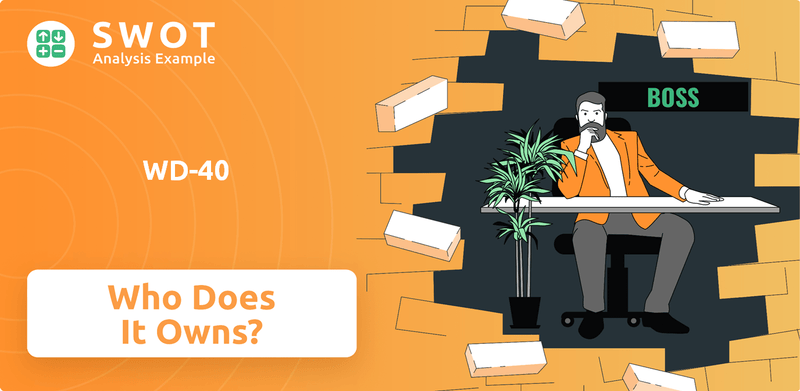
This exploration into WD-40 ownership unveils the WD-40 manufacturer's strategic direction, governance, and market influence. We'll examine the WD-40 history, tracing the shifts from its founders and early backers to the current public shareholders and major institutional investors. Knowing who owns WD-40 helps to understand the company's sustained market position and its commitment to creating 'positive lasting memories' through its problem-solving products, alongside insights into the WD-40 company stock and WD-40 company financials.
Who Founded WD-40?
The story of the WD-40 Company, and who owns WD-40, began in 1953. It started as the Rocket Chemical Company. The focus was on creating rust-prevention solutions for the aerospace industry. The original team was small, consisting of just three individuals.
The core innovation behind WD-40, the 'water-displacing' formula, is credited to Iver Norman Lawson. He reportedly sold the formula to the Rocket Chemical Company for $500. Norman Larsen, the company's president, played a key role in commercializing the product. He came up with the idea of packaging it in aerosol cans and marketing it to consumers. This led to WD-40 becoming available to the public in 1961.
While the exact ownership details among the founders at the beginning aren't fully available in recent filings, the company's early days were clearly centered on solving problems through chemical innovation. This principle remains central to the WD-40 manufacturer's product development and market strategy today.
The WD-40 Company started as Rocket Chemical Company in 1953.
The initial focus was on rust-prevention solutions for the aerospace sector.
The team consisted of only three people.
Iver Norman Lawson is credited with the 'water-displacing' formula.
He sold the formula to Rocket Chemical Company for $500.
The formula is the basis of WD-40's success.
Norman Larsen, the company president, led commercialization.
He conceptualized the product in aerosol cans.
WD-40 became available to consumers in 1961.
The company's vision was rooted in chemical innovation.
This principle continues to guide product development.
It's a key part of their market strategy.
Specific equity splits among founders aren't detailed in recent filings.
Information about early investors is not readily available.
Historical ownership disputes are not highlighted in current information.
The focus remains on solving problems through chemical innovation.
The company continues to develop new products.
This approach shapes its market approach.
Information on early investors and specific agreements is not available in current public disclosures. The company's history shows a focus on innovation, as highlighted in this article about Revenue Streams & Business Model of WD-40. The WD-40 company's annual revenue for fiscal year 2024 was approximately $589.7 million, showing its continued success.
The WD-40 company was founded in 1953 as Rocket Chemical Company.
- Iver Norman Lawson created the WD-40 formula.
- Norman Larsen led the commercialization of WD-40.
- The company's focus has always been on chemical innovation.
- Specific details about early ownership are not widely available.
- The WD-40 company's annual revenue in 2024 was around $589.7 million.
WD-40 SWOT Analysis
- Complete SWOT Breakdown
- Fully Customizable
- Editable in Excel & Word
- Professional Formatting
- Investor-Ready Format
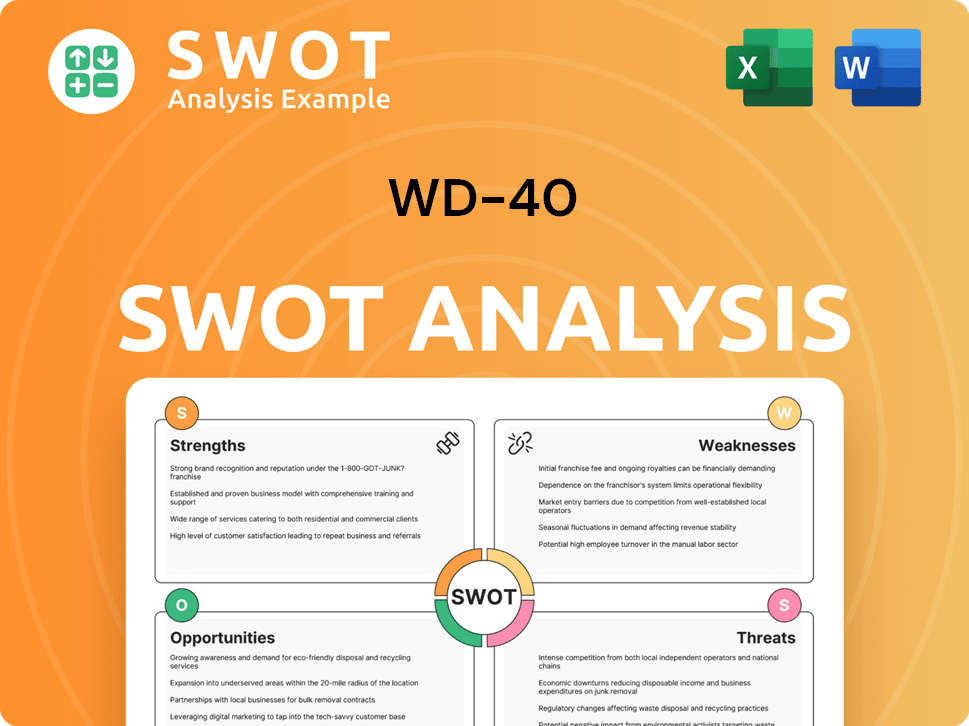
How Has WD-40’s Ownership Changed Over Time?
The WD-40 Company's journey from a private entity to a publicly traded company marked a significant shift in its ownership structure. The transition occurred on May 2, 1973, when the company began trading on the NASDAQ Global Select Market under the ticker symbol 'WDFC'. This move opened the door for a broader range of investors to participate in the company's growth.
As of October 15, 2024, the total shares outstanding stood at 13,541,081. This figure is crucial for understanding the distribution of ownership and the potential influence of different investor groups on the company's strategic decisions and financial performance. The evolution of its ownership reflects the company's expansion and its integration into the broader financial markets.
| Ownership Type | Percentage | Details |
|---|---|---|
| Institutional Investors | Approximately 88% (May 21, 2025) | Hold a significant majority of shares, influencing stock price and board decisions. |
| Retail and Individual Investors | Remainder | Comprise the remaining ownership stake. |
| Insiders (Management & Directors) | Under 1% | Hold a small percentage, but with a notable absolute value. |
The ownership of the WD-40 Company is largely dominated by institutional investors. According to data from May 21, 2025, these investors collectively hold approximately 88% of the company's shares. This high level of institutional ownership underscores the importance of understanding the major shareholders and their potential impact on the company. Key institutional investors include BlackRock, Inc., holding roughly 16% of the shares as of March 31, 2025, and The Vanguard Group, Inc., with approximately 12%. Other significant shareholders include Kayne Anderson Rudnick Investment Management LLC, State Street Corporation, and AllianceBernstein L.P. The company's history is detailed in Brief History of WD-40.
The WD-40 Company's ownership structure is primarily institutional, with major players like BlackRock and Vanguard holding significant stakes.
- Institutional investors have a substantial influence on the company's stock performance and strategic direction.
- Understanding the ownership structure is crucial for investors and stakeholders.
- The company's transition to public trading in 1973 marked a pivotal moment in its ownership evolution.
- As of March 31, 2025, insiders held approximately US$10 million worth of shares.
WD-40 PESTLE Analysis
- Covers All 6 PESTLE Categories
- No Research Needed – Save Hours of Work
- Built by Experts, Trusted by Consultants
- Instant Download, Ready to Use
- 100% Editable, Fully Customizable
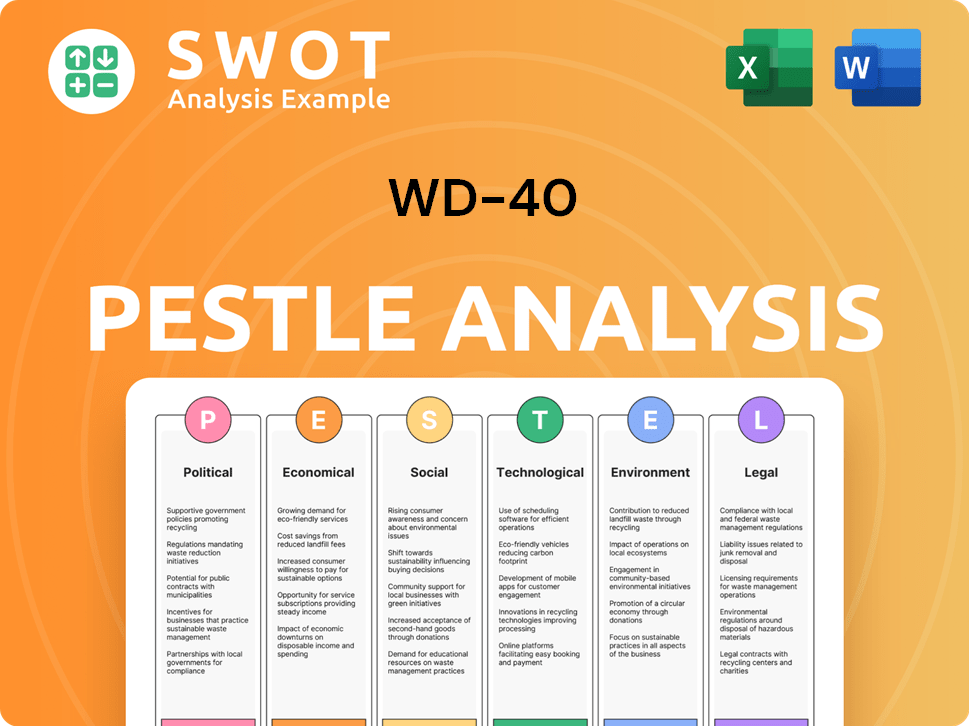
Who Sits on WD-40’s Board?
As of December 12, 2024, the WD-40 company board of directors comprised 10 members. Eric P. Etchart was appointed as the non-executive chairman of the board on December 12, 2024, succeeding Gregory A. Sandfort. Mr. Etchart, who joined the board in 2016, also participates in the Corporate Governance Committee and Finance Committee.
The board's composition reflects the company's governance structure, with directors overseeing the WD-40 manufacturer's strategic direction and financial performance. The board's decisions are crucial for the company's operational success and its ability to adapt to market changes. Details about the board's activities and decisions are available in the company's public filings.
| Director | Role | Joined Board |
|---|---|---|
| Eric P. Etchart | Non-Executive Chairman | 2016 |
| Garry O. Ridge | Director | 1997 |
| Stanley C. W. O'Brien | Director | 2004 |
| William B. Jones | Director | 2013 |
The voting structure for WD-40 company common stock adheres to a one-share-one-vote principle. Stockholders of record as of November 1, 2024, were entitled to one vote per share at the Annual Meeting. At the December 12, 2024, Annual Meeting, holders of 12,679,577 shares of common stock, representing over 93% of the 13,553,739 outstanding shares, were represented virtually or by proxy. This high level of shareholder participation indicates strong engagement in the company's governance.
The WD-40 ownership structure is straightforward, with shareholders exercising voting rights based on their shareholdings. This structure promotes transparency and accountability within the company. For more insights into the WD-40 company and its strategic direction, consider exploring the Growth Strategy of WD-40.
- The company operates under a standard one-share-one-vote system.
- High shareholder participation reflects active engagement in company matters.
- No indication of special voting rights or outsized control.
- Proxy statements detail shareholder votes on key issues.
WD-40 Business Model Canvas
- Complete 9-Block Business Model Canvas
- Effortlessly Communicate Your Business Strategy
- Investor-Ready BMC Format
- 100% Editable and Customizable
- Clear and Structured Layout
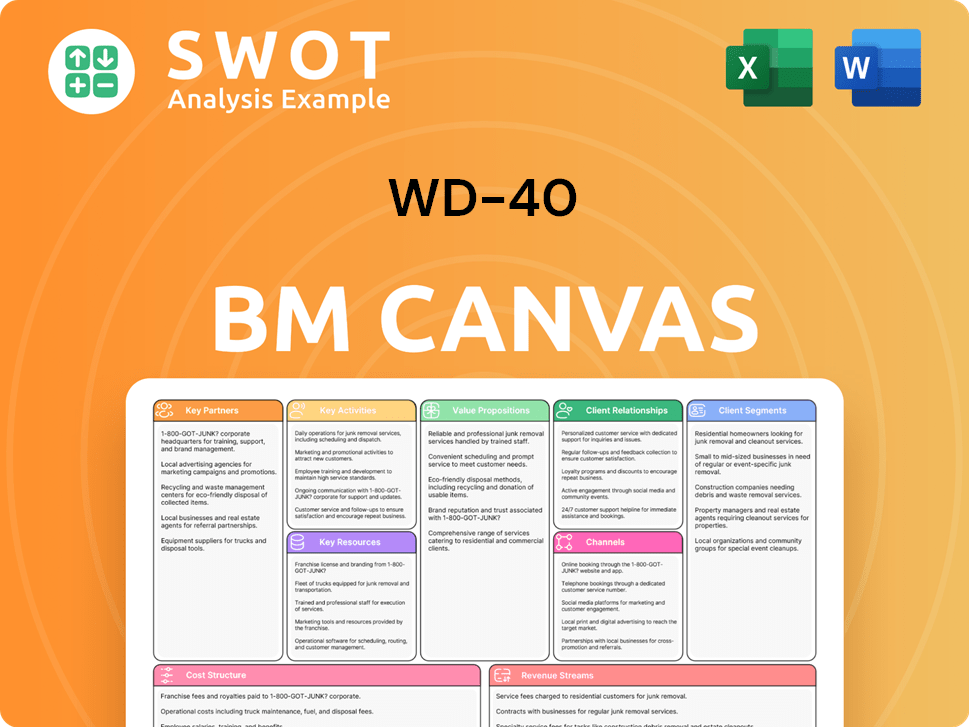
What Recent Changes Have Shaped WD-40’s Ownership Landscape?
Over the past few years, the WD-40 Company has focused on returning capital to its shareholders. A share repurchase plan, effective from September 1, 2023, authorized the acquisition of up to $50.0 million of outstanding shares through August 31, 2025. From September 1, 2024, to February 28, 2025, the company repurchased 26,250 shares for $6.7 million. The share buyback ratio for the six months ending February 2025 was -0.02%, and for the year, it was 0.00%, indicating a stable share count.
The WD-40 Company is also adjusting its product portfolio. It plans to sell its homecare and cleaning product lines in the United States and United Kingdom, shifting its focus to core maintenance products, which made up 95% of total net sales in the second quarter of fiscal year 2025. Additionally, there have been leadership changes, with Eric P. Etchart succeeding Gregory A. Sandfort as non-executive chair on December 12, 2024, reducing the board size to 10 directors.
| Metric | Details | Data |
|---|---|---|
| Share Repurchase Plan | Authorization | Up to $50.0 million |
| Shares Repurchased (Sept 1, 2024 - Feb 28, 2025) | Number of Shares | 26,250 |
| Shares Repurchased (Sept 1, 2024 - Feb 28, 2025) | Total Cost | $6.7 million |
| Share Buyback Ratio (6-month, as of Feb 2025) | Percentage | -0.02% |
| Share Buyback Ratio (1-year) | Percentage | 0.00% |
| Core Maintenance Products (Q2 FY2025) | % of Total Net Sales | 95% |
| Projected Net Sales Growth (FY2025) | Percentage | 6% - 11% |
| Projected Net Sales (FY2025) | Range | $600 million - $630 million |
Industry trends show increasing institutional ownership of WD-40. While founder dilution is typical for public companies, insider ownership remains under 1%. The company is focused on consistent revenue growth, strong profit margins, and shareholder-friendly capital allocation. As of April 8, 2025, the company expects net sales growth between 6% and 11% for fiscal year 2025, with net sales projected between $600 million and $630 million. For more insights, you can explore the Competitors Landscape of WD-40.
The ownership structure of WD-40 is largely influenced by institutional investors. This reflects a common trend in the industry.
The company has an active share repurchase program, which shows its commitment to returning value to shareholders. The program is ongoing.
Recent changes in leadership, such as the appointment of a new non-executive chair, impact the company's governance and strategic direction.
WD-40 is concentrating on its core maintenance products, which is a key strategic move. The company has adjusted its portfolio.
WD-40 Porter's Five Forces Analysis
- Covers All 5 Competitive Forces in Detail
- Structured for Consultants, Students, and Founders
- 100% Editable in Microsoft Word & Excel
- Instant Digital Download – Use Immediately
- Compatible with Mac & PC – Fully Unlocked
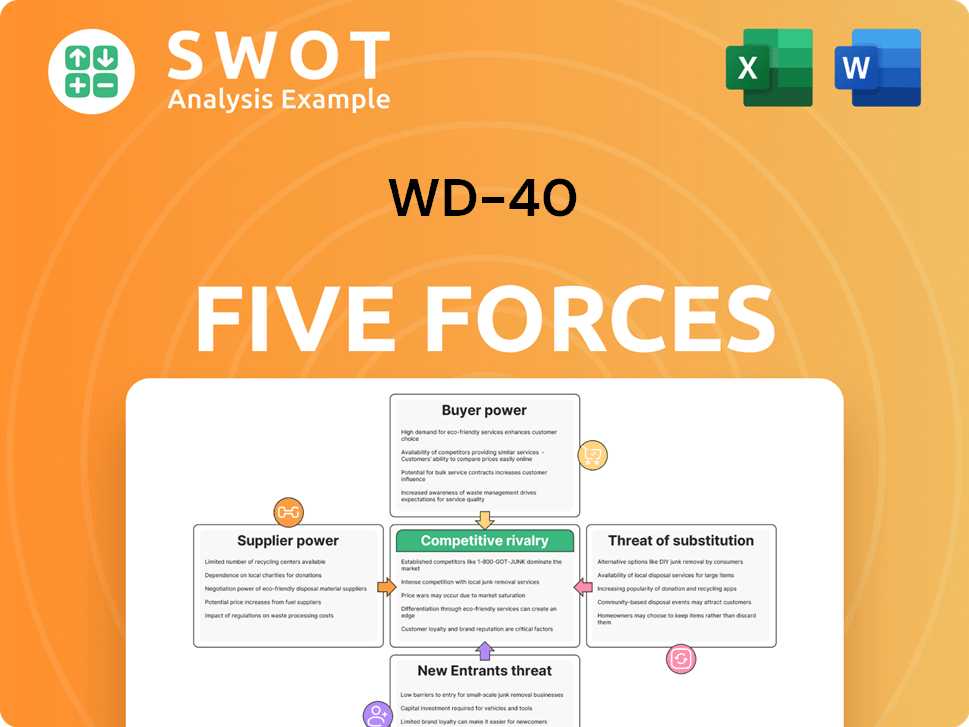
Related Blogs
- What are Mission Vision & Core Values of WD-40 Company?
- What is Competitive Landscape of WD-40 Company?
- What is Growth Strategy and Future Prospects of WD-40 Company?
- How Does WD-40 Company Work?
- What is Sales and Marketing Strategy of WD-40 Company?
- What is Brief History of WD-40 Company?
- What is Customer Demographics and Target Market of WD-40 Company?
Disclaimer
All information, articles, and product details provided on this website are for general informational and educational purposes only. We do not claim any ownership over, nor do we intend to infringe upon, any trademarks, copyrights, logos, brand names, or other intellectual property mentioned or depicted on this site. Such intellectual property remains the property of its respective owners, and any references here are made solely for identification or informational purposes, without implying any affiliation, endorsement, or partnership.
We make no representations or warranties, express or implied, regarding the accuracy, completeness, or suitability of any content or products presented. Nothing on this website should be construed as legal, tax, investment, financial, medical, or other professional advice. In addition, no part of this site—including articles or product references—constitutes a solicitation, recommendation, endorsement, advertisement, or offer to buy or sell any securities, franchises, or other financial instruments, particularly in jurisdictions where such activity would be unlawful.
All content is of a general nature and may not address the specific circumstances of any individual or entity. It is not a substitute for professional advice or services. Any actions you take based on the information provided here are strictly at your own risk. You accept full responsibility for any decisions or outcomes arising from your use of this website and agree to release us from any liability in connection with your use of, or reliance upon, the content or products found herein.